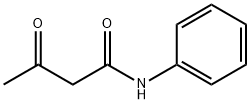| Chemical Properties | Back Directory |
[Appearance]
White to off-white powder |
[Melting point ]
83-88 °C (lit.) |
[Boiling point ]
129°C 24mm |
[density ]
1.26 |
[vapor density ]
6.1 (vs air)
|
[vapor pressure ]
0-0.013Pa at 20-50℃ |
[refractive index ]
1.5168 (estimate) |
[Fp ]
325 °F
|
[storage temp. ]
Refrigerator |
[solubility ]
Chloroform (Slightly), Methanol (Slightly) |
[form ]
Crystalline Powder |
[pka]
12.21±0.46(Predicted) |
[color ]
White |
[Stability:]
Stable. Combustible. Incompatible with strong oxidizing agents. |
[biological source]
synthetic |
[Water Solubility ]
5 g/L (20 ºC) |
[Usage]
Acetoacetanilide (AAA) flakes is used as an intermediate for the manufacture of organic pigments and dyestuffs. For further information consult the Product information sheet. Product Data Sheet |
[Merck ]
14,58 |
[BRN ]
473419 |
[LogP]
0.93 at 23℃ |
[CAS DataBase Reference]
102-01-2(CAS DataBase Reference) |
[NIST Chemistry Reference]
Butanamide, 3-oxo-N-phenyl-(102-01-2) |
[EPA Substance Registry System]
102-01-2(EPA Substance) |
| Safety Data | Back Directory |
[Hazard Codes ]
Xn |
[Risk Statements ]
R21/22:Harmful in contact with skin and if swallowed . |
[Safety Statements ]
S36:Wear suitable protective clothing . |
[RTECS ]
AK4200000
|
[Autoignition Temperature]
843 °F |
[HS Code ]
2921419000 |
[Safety Profile]
Poison by intraperitoneal route. Moderately toxic by ingestion. A weak allergen. See also ACETANILIDE. Combustible when exposed to heat or flame. See ANILINE and CYANIDE for disaster hazard. When heated to decomposition it emits toxic NOx, fumes. To fight fire, use alcohol foam, water mist, CO2, dry chemical. |
[Hazardous Substances Data]
102-01-2(Hazardous Substances Data) |
[Toxicity]
LD50 orl-rat: 5400 mg/kg LONZA# 08FEB79 |
| Hazard Information | Back Directory |
[General Description]
White crystalline solid. |
[Reactivity Profile]
Organic amides react with azo and diazo compounds to generate toxic gases. Flammable gases are formed by the reaction of organic amides with strong reducing agents. Amides are very weak bases (weaker than water). Mixing amides with dehydrating agents such as P2O5 or SOCl2 generates the corresponding nitrile. The combustion of these compounds generates mixed oxides of nitrogen (NOx). Ketones are reactive with many acids and bases liberating heat and flammable gases (e.g., H2). The amount of heat may be sufficient to start a fire in the unreacted portion of the ketone. Ketones react with reducing agents such as hydrides, alkali metals, and nitrides to produce flammable gas (H2) and heat. Ketones are incompatible with isocyanates, aldehydes, cyanides, peroxides, and anhydrides. They react violently with aldehydes, HNO3, HNO3 + H2O2, and HClO4. |
[Air & Water Reactions]
Water insoluble. |
[Health Hazard]
ACUTE/CHRONIC HAZARDS: This compound is a weak allergen. When heated to decomposition it emits toxic fumes. |
[Fire Hazard]
This chemical is combustible. |
[Chemical Properties]
White to off-white powder |
[Uses]
Acetoacetanilide may be used to synthesize:
- azo pigments
- acetoacetanilido-4-aminoantipyrine (Schiff base)
- 6-aryl-2-methyl-4-oxo-N,N′-diphenyl-2-cyclohexene-1,3-dicarboxamides
- photoluminescent lanthanide complexes
|
[Uses]
Acetoacetanilide (AAA) flakes is used as an intermediate for the manufacture of organic pigments and dyestuffs. For further information consult the Product information sheet. Product Data Sheet |
[Uses]
Acetoacetanilide is used as intermediate for the manufacture of organic pigments and dyestuffs. |
[Synthesis Reference(s)]
The Journal of Organic Chemistry, 56, p. 1713, 1991 DOI: 10.1021/jo00005a013 |
[Purification Methods]
Crystallise the anilide from H2O, aqueous EtOH or pet ether (b 60-80o). [Williams & Krynitsky Org Synth Coll Vol III 10 1955.] |





